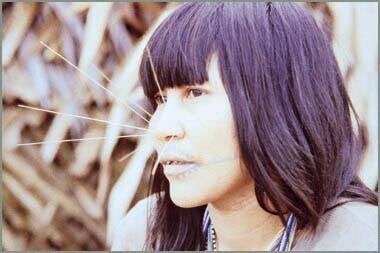The clue is in the name: Complicite. This word, meaning 'involvement in a crime or some activity that is wrong' (Cambridge Dictionaries), resonates with Brechtian dramatic principles, not only in its foregrounding of morality, but also in the notion of audiences as active participants rather than passive recipients.
Simon McBurney's latest play, The Encounter, certainly asks a lot of its audience. Based on Petru Popescu's Amazon Beaming, it tells the story of the American National Geographic photojournalist Loren McIntyre, who gets lost in the Amazon rainforest in 1971 in his search for an indigenous Brazilian community called the Mayoruna. His initial intention - to take photographs that might witness the continued existence of a people that had been declared extinct - turns into a transformative journey of self-discovery. Going in search of the ultimate 'other' - a people whose ways of life seemingly encapsulated the very opposite of modern, Western 'civilization' (a word that recurs throughout the play) - McIntyre finds himself confronted with the depths of his own self.

The Encounter engages the audience in a relationship of complicity in a variety of (seemingly contradictory) ways: through intimacy and distance; through ethical engagement and critical detachment; through bodily participation and philosophical debate.
Upon entering the auditorium, you are asked to put on a pair of head phones. Hearing McBurney's voice not from the distance between the stage and your seat, but 'directly' in your ear, gives a sense of intimacy and participation. Yet McBurney simultaneously undercuts this sensation of directness and immediacy by drawing attention to the artificiality of the play, mobilizing Brecht's alienation effect to distance us from the narrative.
From the very opening, McBurney exposes the constructedness of the narrative by introducing us to the different dramatic techniques and technological devices that he will go on to use. Perhaps most striking is the use of the binaural head, which creates the sensation of three-dimensional presence, giving the audience the illusory impression of being in the middle of the action rather than on its peripheries. Yet this innovative use of recent technology is also combined with the age-old storytelling techniques - a point to which McBurney returns at the end of the play, when he reads to his daughter (one of the characters) a passage from Popescu's novel that tells the Mayorunan myth of the fall of man. As McBurney self-reflexively notes, this story, a product of oral tradition, has been handed down from generation to generation in the Mayorunan community, then told in 1969 by the community's headman (Barnacle) to McIntyre through the medium of the bilingual Portuguese-Mayorunan (Cambio), then re-told by Popescu in a 1993 novel, and then finally in 2016 by McBurney to a full audience in the Barbican.
The play's construction through multiple layered narratives reflects one of the central themes of the play: consciousness, or, as it is phrased in the workshop notes, 'altered states of consciousness and challenging the materialist view' (workshop notes, 3rd April 2014). Philosophically speaking, then, McBurney's play might be seen to adopt an 'idealist' position - privileging of the objects of spirit or mind over the material world, in the line of Plato, Kant, Hegel and Schopenhauer. As McIntyre is stripped of his shoes, his watch, his camera, his water purifier, and so on, he gains a deeper connection with what might be termed his 'inner self', his subjectivity: his states of mind, memories, sensations, bodily experiences, emotions, passions, dreams and delusions.
Paradoxically, though, his transformative journey into the depths of his own consciousness give him access to profound connections with the other. We witness him communicating with the headman Barnacle in spite of language barriers, on an intuitive or pre-symbolic level. This extra-linguistic exchange is translated for the audience by the recurring phrase 'some of us are friends', which punctuates and concludes the play. Just as McIntyre's journey to discover the Mayorunan 'other' leads seamlessly to a confrontation with the self, his intensified self-awareness yields a deeper connection with the other.

Perhaps surprisingly, though, at the heart of a self-reflexive play that explores altered states of consciousness and sets out to 'challenge the materialist view' lies something very tangible, material and immediate: the corporeal, present experience. Sound and light are not only used to tell stories, to convey the workings of the protagonist's mind, but also to produce physical reactions in the audience. The five senses are constantly, powerfully invoked. Most prominent are the sounds (of the plane in which he lands, the river, the jungle, the chanting), but these are conjugated with the feeling of itching produced by the buzzing mosquitoes, stunning plays of light and shadows, and so on. All illusory effects, of course, but also very real.
As a squeamish person who faints at the sight of blood, the bit that most turned my stomach was when we 'see' the Mayorunan people opening their veins to drug themselves in order to 'return to the beginning', to a state of wholeness, during the climactic ritual. But for different audience members, those gut reactions would have occurred at different moments and been experienced differently.
In addition to corporeal experiences, the play represents and produces experiences of what Stacey Alaimo terms 'trans-corporeality'. In the context of an emerging school of thought known as New Materialism, Alaimo highlights the mutual interaction between human bodies and the more-than-human environment, disturbing our notion of the human self by forcing us to recognise that '"the environment" is not located somewhere out there, but is always the very substance of ourselves' (2010). The interactions between the jungle environment and the human body are foregrounded throughout the play, in McIntyre's fear of intestinal parasites, the thorns and worms extracted from his back by the shamans, his bleeding body becoming fuel for mosquitoes and other animals, and the intravenous injection of drugs in the Mayorunan ritual.
Perhaps the closest we get to the 'real' - or at least to the impression of the real, the so-called 'truth effect' - in the play, though, is when McBurney returns to the stage after the inevitable stunned silence and rapturous applause, to deliver a poignant message from the Mayorunan people: 'we exist'. Herein lies another key aspect of our complicity: threaded together by messages of human and environmental injustice, the play makes constant reference to the rubber industry, to oil extraction, to deforestation, making us accomplices in the colonial crimes committed over centuries against this and other indigenous communities and their environments through exploitation, extermination and resource extraction. What we have witnessed, in the end, is not only their fragility and precariousness, but also their continued existence, their resilience.
The final ethical demand of the play is one that touches on the very essence of theatre as encapsulated by a line from Complicite's fascinating workshop notes: 'theatre needs you to be dually present: projecting yourself into the consciousness of those on stage and yet bringing them to life by witnessing their actions, by being present.' (workshop notes, 29th September 2014) As audience members, we are asked to become the characters, but also to be the observer, to witness, to be complicit.
Image attributions:
1/ Brazilian rainforest, http://www.globalmeatnews.com/Industry-Markets/Brazilian-supermarket-body-makes-rainforest-pledge
2/ Mayorunan man, http://www.peruecologico.com.pe/etnias_mayoruna.htm
